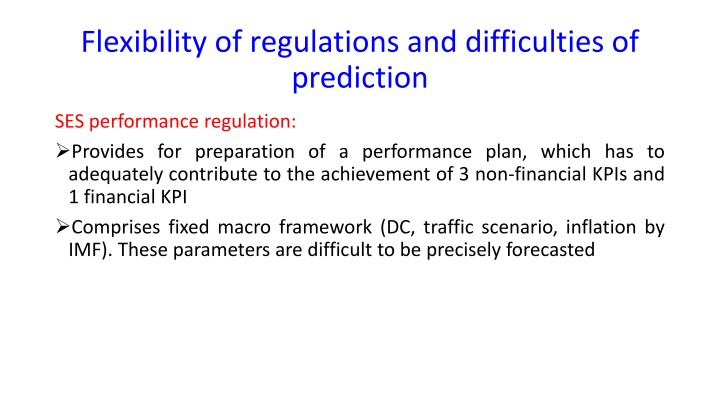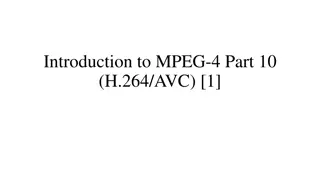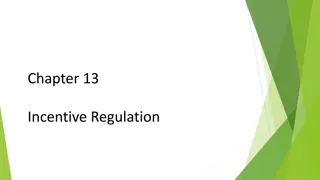Challenges in Flexibility of Regulations and Prediction in SES Performance Regulation
The article discusses the challenges faced in preparing a performance plan that contributes to specific KPIs in SES regulations. It highlights regulatory flexibilities, difficulties in forecasting parameters, conflicts with economic theory, and potential financial constraints. The content emphasizes the importance of adapting to changing demands and the impact on ANSP financing for meeting targets.
Download Presentation

Please find below an Image/Link to download the presentation.
The content on the website is provided AS IS for your information and personal use only. It may not be sold, licensed, or shared on other websites without obtaining consent from the author.If you encounter any issues during the download, it is possible that the publisher has removed the file from their server.
You are allowed to download the files provided on this website for personal or commercial use, subject to the condition that they are used lawfully. All files are the property of their respective owners.
The content on the website is provided AS IS for your information and personal use only. It may not be sold, licensed, or shared on other websites without obtaining consent from the author.
E N D
Presentation Transcript
Flexibility of regulations and difficulties of prediction SES performance regulation: Provides for preparation of a performance plan, which has to adequately contribute to the achievement of 3 non-financial KPIs and 1 financial KPI Comprises fixed macro framework (DC, traffic scenario, inflation by IMF). These parameters are difficult to be precisely forecasted
Flexibility of regulations and difficulties of prediction A) Regulation 2019/317 provides for certain flexibility, stemming from: TRS, CRS, inflation adjustments Note 1: Inflation and traffic scenario might be impacted by events which are far away from local airspace and out of State/ANSP control B) Local circumstances could be used to justify certain deviations Note 2: Whatever the regulation, it should be compatible with economic theory!
Cost curves - Microeconomics Total costs (Fixed costs could be the same over 1 year, but may vary with Q over the years) TC = TFC + TVC AC and MC (MC start growing because of diminishing marginal returns)
Revenue curves normal and regulated Profile of Changes in Revenue versus Plan (Price or Unite Rate Constant) R (if not REG) Max P/L REG U/L Bands REG 60% 50% 40% Y = R = F[ X] 30% 20% 10% 0% -50% -40% -30% -20% -10% 0% 10% 20% 30% 40% 50% -10% -20% -30% -40% -50% -60% X = F [ Q(TF)]
Flexibility of regulations and difficulties of prediction Potential conflict between regulation and economic theory: Demand is exogenous, ANSPs have to meet it. If delta in demand is cumulatively significantly above the forecast, this might lead to a situation, where Additional costs to meet demand > Additional revenue from ANS There is money in the system, but ANSPs are not allowed to spend it This could result in lack of financing for the accrual of sufficient resources to meet non-financial targets [unless the performance plan is revised, which is a time-consuming exercise]
Flexibility of regulations and difficulties of prediction Conclusions: 1. ANSPs could often operate in a situation which is contradictory to economic theory due to limited flexibility of the regulatory framework 2. Interdependencies between all 4 KPIs need to be elaborated clearly in order to give a meaningful way forward for regulatory amendments while improving performance.























